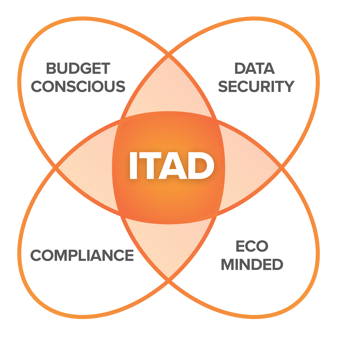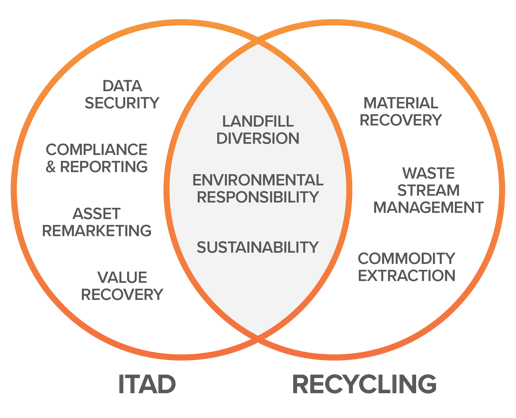When technology reaches the end of its life in your organization, you’ve got two main paths: IT Asset Disposition (ITAD) or Recycling.
Both aim to keep old devices out of landfills, but the similarities pretty much end there. Choosing the right route impacts everything from data security to financial return — and it’s not a decision to take lightly.
What is ITAD?
IT Asset Disposition is a comprehensive, strategic process for managing retired technology. It goes far beyond simply “getting rid” of old hardware.
Key elements of ITAD:
- Secure data destruction using certified processes (e.g. R2v3, NIST 800-88 standards)
- Remarketing and resale of devices to recover maximum value
- Detailed tracking and reporting for every asset
- Regulatory compliance with certifications like R2v3, ISO 9001, ISO 14001, ISO 45001
Why organizations choose ITAD:
- Maximize residual value from usable devices
- Protect sensitive information with airtight data security
- Meet internal and external compliance requirements
- Get transparent, auditable reports on exactly what happened to every asset

What is Recycling?
Recycling focuses on breaking down old equipment into raw materials like metals, plastics, and glass. It’s a vital environmental process, but it’s not designed to handle security, resale, or compliance in depth.
Key elements of recycling:
- Material separation and shredding
- Extraction of valuable raw materials (gold, copper, aluminum, plastics)
- Proper management of waste streams to prevent landfill dumping
Why organizations choose recycling:
- Environmentally responsible disposal
- Recover commodity materials for reuse
- Useful for assets with little to no resale value
Side-by-Side Comparison
| Factor |
ITAD |
Recycling |
| Primary Goal |
Maximize asset value and ensure security |
Recover raw materials for environmental gain |
| Data Security |
Certified, documented data destruction |
Minimal or secondary (unless certified) |
| Resale Potential |
High — remarketing is a core focus |
Rarely, if ever |
| Compliance |
Strong — meets regulatory and certification standards |
Less stringent |
| Environmental |
Prefers reuse first, then recycle |
Focused on recycling only |
| Financial Return |
Often significant via resale |
Limited to commodity value |

When to Use Each
-
ITAD: Use when devices still have value, contain sensitive data, or when compliance and documentation are essential.
Example: A batch of laptops from a recent upgrade that still function well.
-
Recycling: Use when devices are obsolete, broken beyond repair, or have no resale market.
Example: Shredded circuit boards, damaged monitors, or outdated peripherals.
The Big Takeaway
Think of ITAD as a full-service solution—it’s where compliance, data security, environmental responsibility, and fiscal responsibility meet. Recycling is an important part of that ecosystem, but it’s a narrower tool, focused purely on material recovery.
If your assets still hold value and sensitive data, ITAD should be your go-to. If they’re at the point of no return, recycling keeps them out of the landfill responsibly.